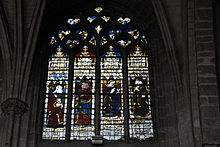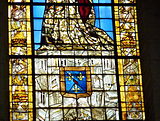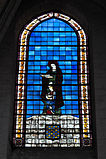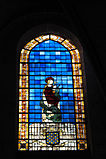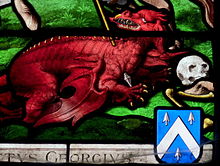St-Pierre (Dreux)
The Catholic parish church of Saint-Pierre in Dreux , a town in the Eure-et-Loir in the French region of Center-Val de Loire , was in the 13th century in the style of Gothic begun. The construction was not completed until the beginning of the 17th century. The church has numerous stained glass windows from the Renaissance and 19th century. In 1840 the church was added to the list of architectural monuments in France as a monument historique .
history
There is evidence of a church consecrated to the Apostle Peter in Dreux as early as 1100 . The oldest parts of today's church, the north transept , the crossing , the choir vault and the four east bays of the side aisles go back to the 13th century. During the Hundred Years War the building was badly damaged and after 1474 the reconstruction started. First, the pillars of the choir and the four eastern bays of the main nave were renewed. According to the original plans of the 13th century, a double ambulatory with six chapels was built. Chapels were also added to the side aisles. At the beginning of the 16th century the nave was extended by two bays to the west. The west facade with the main portal was built under the direction of the architects Jean des Moulins and Clément Métezeau. At the end of the 16th century, Jehan Métezeau built the north tower. The south transept was completed in the early 17th century. The south tower remained unfinished.
During the French Revolution , the church was stripped of its art treasures and furnishings. In 1794 the building was declared the Temple de la Raison ( Temple of Reason ), the transept and choir were used as a saltpeter factory. The sculptures on the portals were chopped off, the tympana walled up. The bells were melted down, the altars, pulpit, pews and the carved rood screen were smashed or sold. In 1802 the completely empty building was used again for worship. The church furnishings were partly newly created or taken over from other churches.
In 1866 the parish council had the wall paintings from the 15th and 16th centuries removed, which had been preserved in several side chapels until then.
architecture
Exterior construction
- Main portal
The main portal was created between 1510 and 1524. The entry of Jesus into Jerusalem can be seen on the tympanum . On the inner archivolt the four church fathers and the four evangelists are depicted, on the outer archivolt Sibyls announcing the arrival of the Savior to the Gentiles . The figures of the tower and the niches have not been preserved.
- North portal
The north portal was built in the first quarter of the 13th century. On the tympanum, Christ is depicted as the judge of the world, framed by a mandorla and surrounded by angels. The resurrection of the dead can be seen on the lintel. The archivolts are also studded with figures. Remnants of paint are reminiscent of the original painting on the portal.
inner space
The nave has three aisles and is illuminated by large tracery windows in flamboyant style . Instead of a triforium, smooth wall surfaces that were originally hung with tapestries have been inserted between the window area and the pointed arch arcades of the central nave . Instead of capitals, the columns are carved with leaf garlands or depictions of animals. The main and side aisles are covered by ribbed vaults. Large pointed arches open the crossing to the nave and the choir.
The choir still has its vault from the 13th century. The double ambulatory in the flamboyant style from the late 15th century is divided into seven bays. The keystones of the vault are decorated with coats of arms, foliage and figures.
On the west wall a door with Renaissance decor leads to the north tower.
Leaded glass windows from the Renaissance
- Apostle window
|
Of the large windows of the nave, only one of the original lead glazing from the late 15th century has been preserved. Four apostles are depicted standing in niches under canopies, although the name inscriptions do not match the people depicted. |
- Window of the Confrérie de la Charité
|
The window (n ° 29) in the Chapelle Saint-Vincent, on which tears, death bells and skulls can be seen, is reminiscent of the Confrérie de la Charité (Brotherhood of Mercy), which was mainly concerned with the burial of the dead. The window is composed of various fragments. The small medallions in the tracery with the prophet Isaiah (above), St. Sebastian (left) and St. Rochus (right) are from the 16th century, as is the figure of Mary on the left lancet. The depiction of the apostle John with a chalice from which a dragon escapes on the right lancet is dated to the 15th century. A Pietà can be seen on the middle pane . The small disc in the lower center with the martyrdom of St. Sebastian dates from the 17th century. |
- Holy House of Nazareth
|
The theme of the grisaille window (n ° 27) in the Chapelle Sainte-Madeleine from the 16th century is the miraculous transfer of the Holy House from Nazareth to Loreto in Italy. It is revered as the house where Maria is said to have grown up. |
- Legend of St. Fiacrius
|
The window (n ° 25) in the Chapelle Saint-Fiacre has been preserved from the 16th century and tells the story of Saint Fiacrius , a Scottish king's son who opposed his father's plans to marry and embarked for France to be a hermit live (bottom center). He vows obedience to St. Faron, the Bishop of Meaux (bottom left), who promises him the entire area around which he can dig a trench with his spade. Fiacrius is accused of witchcraft by Becnaude (center left), he defends himself in front of Faron (center). Fiacrius is offered the Scottish royal crown, which he refuses (center right). He saves two children from drowning (top left). His relics are transferred in a shrine (top center), pilgrims pray in front of his reliquary (top right). |
- Chapelle de la Vierge (Lady Chapel)
|
Six of the seven windows in the Lady Chapel date from the 15th and 16th centuries. Only the middle window was recreated by Eugène Moulin in 1857. The six discs represent scenes from the life of Jesus. |
- Window 5
|
The outer left window is dedicated to the childhood of Mary and contains the scenes of the rejection of the sacrifice of Anna and Joachim by the high priest due to their childlessness, the announcement of the birth of a child to Joachim, the announcement of the birth of a child to Anna, the meeting of Anna and Joachim at the Golden Gate, the birth of Mary, the instruction of Mary by Anna and Mariä Tempelgang. On the lower right disk, the foundresses are shown with their patron saints, Saint Stephen and the Apostle Peter. |
- Window 3
|
The window is composed of panes of different origins. The disciples of Emmaus can be seen on the upper right pane, the scene of the death of Mary in the lower right. On the top left you can see a bishop receiving communion in his bed. |
- Window 1
|
The eight scenes from Jesus' childhood and public ministry were created by Pierre Courtois between 1470 and 1480. They show the killing of the innocent children, the flight to Egypt, Jesus among the scribes, the wedding in Cana , the meeting of Jesus with the Samaritan woman, the last supper, Jesus and the adulteress as well as the wonderful multiplication of the bread. The signature of the glass painter Pierre Courtois can be seen on the jug of the Samaritan woman. |
- Window 2
|
The window from the early 16th century is dedicated to the passion of Jesus. The following are shown: Jesus and the sleeping disciples on the Mount of Olives; Judas kiss and the arrest of Jesus; Flagellation of Jesus; Jesus before the high priest Caiaphas, who tears his garment; Mocking Jesus; Jesus before Pilate; Jesus carries the cross and meets Veronica. |
- Window 4
|
On the window are the scenes from the death of Jesus on the cross up to his ascension to heaven. Only the panes depicting the disciples of Emmaus, the unbeliever Thomas and the ascension of Jesus are dated to the 16th century, the other panes are later additions. |
- Window 6
|
The outer right window from the 16th century tells the legend of St. Fiacrius in similar episodes as the window in the Fiacrius chapel in the north aisle. Fiacrius refuses to marry and fled to France, where he asked the Bishop of Meaux to be allowed to settle in his diocese. With his spade he digs a trench around the area where he and his companions want to settle. An old woman, Becnaude, accuses him of witchcraft. Fiacrius defends himself before the Bishop of Meaux. He receives visits from high personalities who ask him for advice. His reliquary is visited by numerous pilgrims. The two scenes below show the transfer of his relics and how he saves two children from drowning. |
- Upper choir window
|
The upper choir windows date from the 15th century. Christ on the cross is depicted on the central window, Mary on the left and the Apostle John on the right. The three windows were restored in the workshop of Jean Le Vieil in 1753 . |
Coats of arms can be seen at the bottom of all three windows. The coat of arms under the cross of Christ recalls the house of Albret , which owned the County of Dreux from the 14th to the middle of the 16th century . The coat of arms under the representation of Mary refers to Louis de Bourbon , the Count of Soissons, who was Count of Dreux from 1612 to 1641. His mother's coat of arms, Anne de Montafié, can be found on the window with the representation of John.
The other upper choir windows with depictions of the instruction of Mary, a bishop, St. Catherine and St. Margaret also date from the 15th century and were formerly in the nave. After their restoration in 1844, they were installed in their current location in the choir.
- South transept
|
Two windows with old panes have been preserved in the south transept. A deposition from the cross is depicted on a window, the scene of the entombment was supplemented in 1894 by the glass painting Lorin. The other window is dated 1607 and shows the sacrifice of Isaac. Donors are shown in the lower area. |
- Ascension of Christ
|
The window in the Chapelle Sainte-Philomène from the first third of the 16th century illustrates the words of the Acts of the Apostles “Men of Galilee, what are you standing there looking up at heaven? This Jesus, who left you and was taken into heaven, will come again just as you saw him go to heaven ”(1.11 EU ). The text can be read in Latin inscription on the banners held by two angels. In the lower area, Mary and the apostles are depicted looking up. On the middle lancet above the feet of Jesus can be seen, who has almost completely disappeared in a cloud. |
- Martyrdom of St. Crispinus and St. Crispinianus
|
The window in the Chapelle Saint-Crépin and Saint-Crépinien from the 16th century depicts the martyrdom of the two brothers Crispinus and Crispinianus in six scenes . The panes in the lower row are no longer preserved and have been replaced by fragments from other windows. Crispinus and Crispinianus belonged to a rich Roman family. They distributed their wealth to the poor, left their homeland and settled in Soissons as shoemakers. There they converted so many people that Emperor Maximian had them arrested by his prefect Rictius Varus. The two brothers have to appear before the emperor and his prefect (center left), they are hung on ropes and tied to tables where their skin is cut open (top left). Their hands are wedged in wooden boards and awls are pushed under their fingernails (top center). Millstones are tied around their necks and they are pushed into the Aisne , but can escape to the other bank (middle right). Even in the kettle with boiling oil, the two suffer no damage (middle row, middle). While the brothers get out of the oil boiler unharmed, Rictius Varus throws himself into the fire in anger (top right). In the right medallion of the tracery you can see the reliquary of the martyrs, above a Madonna and Child. |
- Christ on the cross
|
The window in the Chapelle Saint-Martin dates from the 16th century. In the middle it depicts Christ on the cross, whose right side the soldier Longinus sticks with a lance. Mary Magdalene kneels at the foot of the cross. On the right hand of Jesus, Dismas , the converted thief, is tied to the cross, whose soul is received by an angel. To the left of Jesus is the cross of the unrepentant thief Gestas , whose soul is seized by a green devil. Soldiers gesticulate under his cross and a banner reads: “VERE FILIUS ERAT ESSTE” (Truly this was God's Son). The apostle John, Mary and the mourning women are grouped under the cross of the good thief. God the Father is enthroned in the tracery. The three lower panes are fragments of other windows. On the left pane you can see the resurrection of the dead as they rise from their graves. |
Leaded glass window from the 19th century
- Chapelle Sainte-Clotilde
|
The window was made in 1895 in the Duhamel-Marette stained glass workshop in Evreux . In the center of the tracery, which also contains older fragments, is shown Saint Clothilde , the second wife of Clovis , who contributed significantly to his conversion and baptism. St. George (bottom left), St. Valentina (bottom right), Anthony of Padua (top left) and St. Christopher (top right) can be seen on the other panes. |
- Chapelle Notre-Dame de Pitié
|
The window with the scenes of the Sorrowful Rosary is dated 1885 and bears the signature of the glass painters Küchelbecker and N. Jacquier from Le Mans . The window with the scenes of the Glorious Rosary has a window from the 16th century in the tracery, on which Jesus is walking on the water and Peter threatens to sink. |
- Chapelle Sacré-Cœur
|
The windows of this chapel were made by Eugène Moulin. The Wurzel-Jesse window from 1877 is modeled on a stained glass window from the 16th century. The window with scenes from the life of Jesus bears the signature: EUG. MOULIN A DREUX. 1880. |
- Chapelle Saint-Joseph
|
The window from 1877 with scenes from the life of Joseph also comes from the workshop of Eugène Moulin. On the other window the Adoration of the Shepherds and the death of Mary are depicted. The scene of the death of the Virgin contains fragments from the 16th century, as does the tracery of the Joseph window with the depiction of Gregory's mass . |
literature
- Charles Jobert: Église Saint-Pierre de Dreux . Edited by Paroisse Saint-Étienne-en-Drouais, Dreux 2013.
- Jean Lelièvre: L'Église Saint-Pierre de Dreux . Les Ateliers de la Pierre-Qui-Vire, La Pierre-Qui-Vire 1981.
Web links
- Église Saint-Pierre in the Base Mérimée of the French Ministry of Culture (French)
- Leaded glass window in the Base Palissy of the French Ministry of Culture (French)
- Église Saint-Pierre patrimoine-religieux (accessed August 25, 2015, in French)
Individual evidence
- ↑ Window 29 in Base Palissy of the French Ministry of Culture (French)
- ↑ Window 27 in Base Palissy of the French Ministry of Culture (French)
- ↑ Windows 6 and 25 in Base Palissy of the French Ministry of Culture (French)
- ↑ Windows 3, 5, 13 and 18 in the Base Palissy of the French Ministry of Culture (French)
- ↑ Windows 3, 5, 13 and 18 in the Base Palissy of the French Ministry of Culture (French)
- ↑ Window 1 in Base Palissy of the French Ministry of Culture (French)
- ↑ Windows 2, 4, 16, 21, 22, 26 and 33 in Base Palissy of the French Ministry of Culture (French)
- ↑ Windows 2, 4, 16, 21, 22, 26 and 33 in Base Palissy of the French Ministry of Culture (French)
- ↑ Windows 6 and 25 in Base Palissy of the French Ministry of Culture (French)
- ↑ Windows 100 to 102 in Base Palissy of the French Ministry of Culture (French)
- ↑ Windows 103 to 106 in Base Palissy of the French Ministry of Culture (French)
Coordinates: 48 ° 44 ′ 10.1 ″ N , 1 ° 22 ′ 6.4 ″ E





